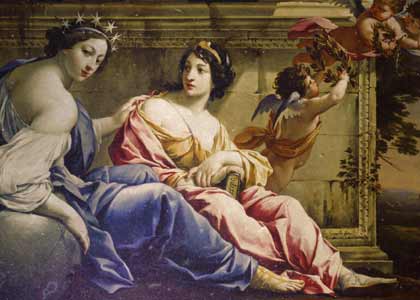“Agitated Style” of the Baroque in Italian Opera
Opera was one of the main achievements of the musical art of the Baroque. As a new synthetic genre, it was intended to embody the ideals of the “new style”. The emergence of this genre was carefully prepared in the artistic atmosphere of the Renaissance. (On the pages of the 10th grade textbook, we talked about the famous Florentine Camerata and the birth of the opera.)
 In the XVII century. operatic art is rapidly developing and flourishing in the largest cities in Italy. There arose a kind of operatic schools, the best features of which were successfully combined in his work by Claudio Monteverdi (1567-1643), the first opera composer of the Baroque and a brilliant reformer of this genre (unfortunately, very little has come down to us from the operatic heritage of the composer). He successfully continued the work started by the participants of the Florentine Camerata, but in his own work he went much further than his predecessors. Monteverdi deepened the meaning of the opera, expanded the expressive means and forms of vocal and orchestral parts, introduced an overture and a duet into it. But his main innovation was the “agitated style” (conci-tato) he created, which conveys the drama and intensity of action, the depth of passionate human feelings and experiences.Unlike his predecessors, he developed the dramatic essence of the new genre, created a melody that combines speech intonation, declamation and vocals. He enriched the opera with a polyphonic tradition, and by means of music he showed the diversity and contradictions of human characters.
In the XVII century. operatic art is rapidly developing and flourishing in the largest cities in Italy. There arose a kind of operatic schools, the best features of which were successfully combined in his work by Claudio Monteverdi (1567-1643), the first opera composer of the Baroque and a brilliant reformer of this genre (unfortunately, very little has come down to us from the operatic heritage of the composer). He successfully continued the work started by the participants of the Florentine Camerata, but in his own work he went much further than his predecessors. Monteverdi deepened the meaning of the opera, expanded the expressive means and forms of vocal and orchestral parts, introduced an overture and a duet into it. But his main innovation was the “agitated style” (conci-tato) he created, which conveys the drama and intensity of action, the depth of passionate human feelings and experiences.Unlike his predecessors, he developed the dramatic essence of the new genre, created a melody that combines speech intonation, declamation and vocals. He enriched the opera with a polyphonic tradition, and by means of music he showed the diversity and contradictions of human characters.
The composer believed that music should not so much entertain the listener as convey the wealth of a person’s inner world, make him think, worry, seek answers to difficult life questions. The mobile, changeable melody of his operas could move and excite to the depths of the soul, plunge into confusion, make him horrified or cause delight.
The plots of his operas included intrigues, conspiracies, treason, assassination; the death of the heroes was an indispensable condition conveying the tension of the development of the action. He created a new type of aria – the “mournful song”, an excellent example of which is “Lamentations of Ariadne” from the opera “Ariadne”. The most important achievement of the composer was the detailed development of the orchestration, the introduction of new techniques for greater expressiveness. Monteverdi used an ensemble of instruments. If in the first opera “Eurydice” there were only seven of them, then in the last – 70!
The best operas of Monteverdi – Orpheus (1607), The Coronation of Poppea (1642), created on mythological and historical themes, are distinguished by the richness and amusing plot. Unexpected events and changes take place in the fates of the heroes, and therefore the music is replete with contrasting, abrupt transitions, full of harsh dramatic power and gentle lyricism. The sound of various musical instruments picturesquely sets off the psychological state of each of the characters, reveals their moral qualities. Orchestral music not only accompanies the singing voice, flexibly following the poetic word, it itself becomes a full participant in the events.
In 1637, on the initiative of Monteverdi, the world’s first public opera house was opened in Venice; a few years later, similar theaters were opened in London, Hamburg, Paris, Prague and Vienna. Opera art is winning the hearts of listeners everywhere. The work of C. Monteverdi had a tremendous influence on the operatic works of G. Frescobaldi (1583-1643), A. Scarlatti (1660-1725) and J. B. Pergolesi (1710-1736).
The characteristic features of the “excited style” of D. B. Pergolesi K. Monteverdi were reflected in the work and performing style of the outstanding masters of the baroque concert, and above all Antonio Vivaldi (1678-1741) – the author of 465 (!) Concerts and 40 operas, a brilliant squeak cha-virtuoso, who amazed the audience with a manner of performance full of surprises and contrasts. The big concert (concerto grosso) he created was based on the opposition of one or a group of solo musical instruments to the entire orchestra.
A. Vivaldi entered the history of musical culture as an outstanding composer of program music that recreates real sound pictures from the life of nature. In his most famous work The Four Seasons (1725), he was able to masterfully convey the joyful spring renewal of nature and the hot summer heat, its lush autumn wilting and winter cold.


